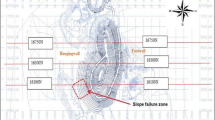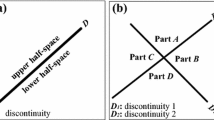Abstract
The safety factor of the slope subjected to wedge failure under surcharge load and uplift forces was obtained using an analytical model. A detailed parametric study conducted for the physical slope involved examining the impacts of the surcharge loads and uplift forces acting along the joint planes due to water pressure on the safety factor of the slope subjected to wedge sliding. The study results indicated that the safety factor of the slope susceptible to wedge sliding decreases with an increase in the surcharge loads and the uplift forces acting along the joint planes due to water pressure. The reduction in the safety factor due to an increase in the surcharge load is independent of the uplift forces acting along the joint planes. The rate of deterioration in the stability of the rock slope susceptible to wedge sliding depends on the rate of increase in the surcharge loads and uplift forces acting along the joint planes due to water pressure. The proposed expression can be useful for analytical stability analyses of the rock slopes subjected to wedge sliding induced by the surcharge load and uplift forces.


Similar content being viewed by others
References
Abramson LW, Thomas S, Sharma S, Boyce GM (2002) Slope stability and stabilization methods, 2nd edn. Wiley, New York. ISBN 0-471-38493-3
Bell FG (2007) Engineering geology. Butterworth-Heinemann, Oxford, pp 581–583
Bowa VM, **a Y (2018a) Stability analyses of jointed rock slopes with counter-titled failure surface subjected to block toppling failure mechanisms. Arab J Sci Res Artic Civ Eng 43(10):5315–5331
Bowa VM, **a Y (2018b) Modified analytical technique for block toppling failure of rock slopes with counter-tilted failure surface. Indian Geotech J 48(4):713–727
Brideau MA, Roberts NJ (2015) Mass movements in bedrock. In: Davies T, Shroder JF (eds) Landslides hazards, risks and disasters. Academic Press, Amsterdam, pp 43–90
Chaulya SK, Prasad GM (2016) Slope failure mechanism and monitoring techniques. In: Sensing and monitoring technologies for mines and hazardous areas, pp 1–86
Cruden DM, Varnes DJ (1996) Landslide types and processes. In: Turner K, Schuster RL (eds) Landslides: investigation and mitigation. National Research Council, Transportation Research Board, Washington, Special Report 247, pp 36–75
Dahal RK, Hasegawa S, Masuda T, Yamanaka M (2006) Roadside slope failures in Nepal during torrential rainfall and their mitigation. In: Marui et al (eds) Disaster mitigation of debris flows, slope failures and landslides. University Academy Press, Tokyo, pp 503–514
Ermias B, Raghuvanshi TK, Abebe B (2017) Landslide hazard zonation (LHZ) around Alemketema town, north Showa zone, and central Ethiopia—a GIS based expert evaluation approach. Int J Earth Sci Eng 10(1):33–44
Hamza T, Raghuvanshi TK (2017) GIS based landslide hazard evaluation and zonation—a case from Jeldu district, central Ethiopia. J King Saud Univ Sci 29(2):151–165
Hocking G (1976) A method for distinguishing between single and double plane sliding of tetrahedral wedges. Int J Rock Mech Min Sci Geomech Abstr 13(1):225–226
Hoek E (2009) Fundamentals of slope design. Keynote address at slope stability 2009, Santiago, Chile, 9–11 November 2009. www.slopestability.cl. Accessed Aug 2018
Hoek E, Bray JW (1981) Slope engineering. Inst. Min. Metall., London
Hoek E, Bray J, Boyd J (1973) The stability of a rock slope containing a wedge resting on two intersecting discontinuities. Q J Eng Geol 6(1):22–35
Hossain MM (2011) Stability analysis of anchored rock slopes against plane failure subjected to surcharge and seismic loads. http://ro.ecu.edu.au/theses/139. Accessed 18 Dec 2017
John KW (1970) Engineering analysis of three dimensional stability problems utilizing the reference hemisphere. In: Proceedings of the 2nd international congress of international society on rock mechanics, Belgrade, vol 2(1), pp 314–321
Kulatilake PHSW, Wang L, Tang H, Liang Y (2011) Evaluation of rock slope stability for Yujian river dam site by kinematic and block theory analyses. Comput Geotech 38(1):846–860
Lee CY, Wang IT (2011) Analysis of highway slope failure by an application of the stereographic projection. Int J Environ Chem Ecol Geol Geophys Eng 5(3):122–129
Li AJ, Merifield RS, Lyamin AV (2008) Stability charts for rock slopes based on the Hoek–Brown failure criterion. Int J Rock Mech Min Sci 45(5):689–700. https://doi.org/10.1016/j.ijrmms.2007.08.010
Nawari O, Hartmann R, Lackner R (1997) Stability analysis of the rock slopes with the direct sliding blocks method. Int J Rock Mech Min Sci 34(4):220
Sharma S, Raghuvanshi T, Anbalagan R (1995) Plane failure analysis of rock slopes. Geotech Geol Eng 13:105–111
Shukla SK, Khandelwal S, Verma VN, Sivakugan N (2009) Effect of surcharge on the stability of anchored rock slope with water filled tension crack under seismic loading condition. Geotech Geol Eng 7(4):529–538
Tang H, Yong R, Ez Eldin MAM (2016) Stability analysis of stratified rock slopes with spatially variable strength parameters: the case of Qianjiang** landslide. Bull Eng Geol Environ. https://doi.org/10.1007/s10064-016-0876-4
Wyllie DC, Mah CW (2004) Rock slope engineering in civil and mining engineering, 4th edn. Taylor and Francis Group, London, pp 45–65
Yang XL, Zou JF (2006) Stability factors for rock slopes subjected to pore water pressure based on the Hoek–Brown failure criterion. Int J Rock Mech Min Sci 43(7):1146–1152
Yang XL, Li L, Yin JH (2004) Stability analysis of rock slopes with a modified Hoek–Brown failure criterion. Int J Numer Anal Methods Geomech 28(2):181–190. https://doi.org/10.1002/nag.330
Funding
This work was supported by the National Natural Science Foundation of China (Grant No. 51374163).
Author information
Authors and Affiliations
Corresponding author
Additional information
Publisher's Note
Springer Nature remains neutral with regard to jurisdictional claims in published maps and institutional affiliations.
Rights and permissions
About this article
Cite this article
Bowa, V.M. Wedge Sliding Analysis of the Rock Slope Subjected to Uplift Forces and Surcharge Loads Conditions. Geotech Geol Eng 38, 367–374 (2020). https://doi.org/10.1007/s10706-019-01027-4
Received:
Accepted:
Published:
Issue Date:
DOI: https://doi.org/10.1007/s10706-019-01027-4




